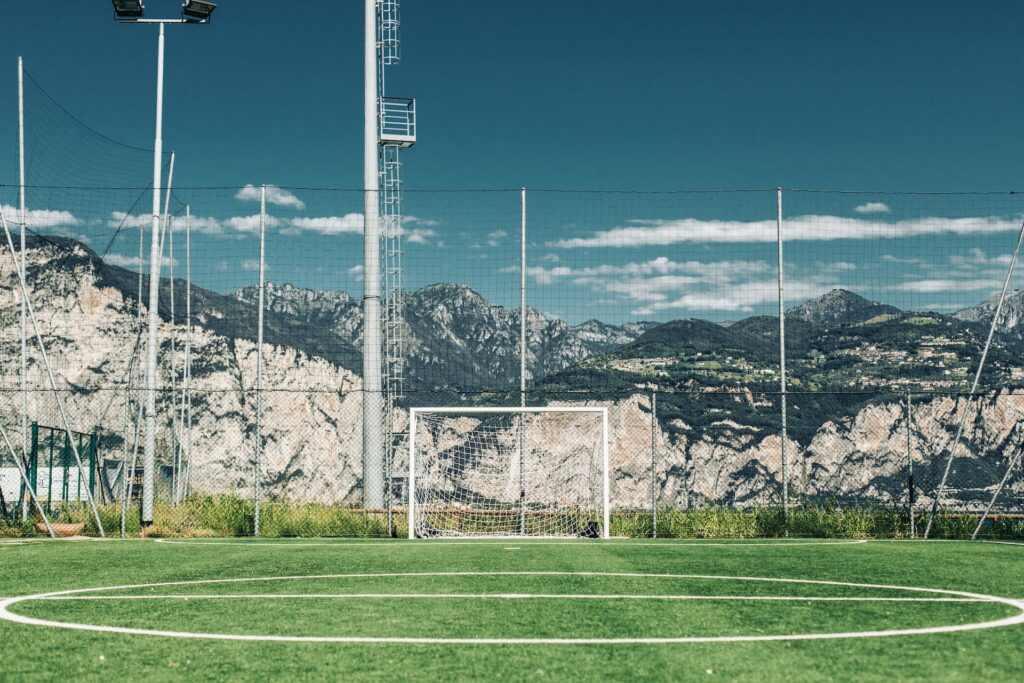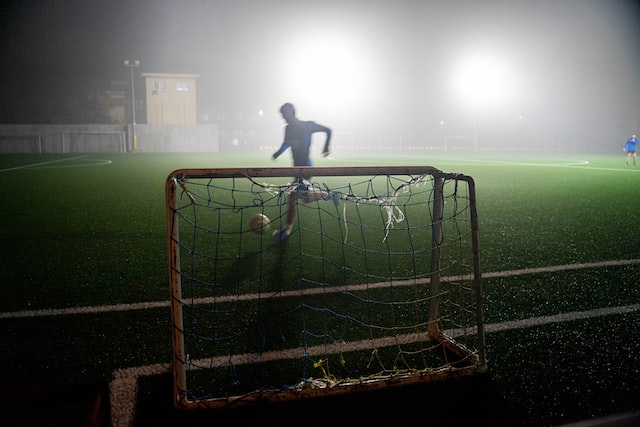6 v 6 soccer, or 6-a-side soccer as you might see it called, is an increasingly popular format of the game which is often more accessible than 11 v 11 soccer. For those looking to get into the sport, the condensed pitch might make 6 v 6 soccer more appealing and means that you’re likely to find 6 v 6 pitches in more heavily populated areas where you’re less likely to encounter the traditional-sized pitches.
Yet despite its easier-to-organize nature, teams participating in 6 v 6 leagues will often have some structure. Let’s look at some of the best ways to line up and operate within 6 v 6 soccer.
What is the best formation to use in 6v6 soccer?
A lot of teams like to approach 6 v 6 soccer with a balanced formation, such as 2-2-1 or 2-1-2. Having two defenders offers the midfield a license to focus on generating attacks rather than having to worry about covering defensive duties.
Before we dive too deep into the topic, if you’re new to the sport, when we talk about our soccer formations, we don’t include the goalkeeper as one of the figures. So, when I mention a 2-2-1 formation, I am referring to 6 v 6 soccer despite the 2-2-1 only totalling 5.
6 v 6 soccer tends to be more transient than 11 v 11 soccer, however. This is partly due to the smaller playing area putting less emphasis on strict positions, but knowing which area of the field each player should be situated in is important.
Ultimately, the formation you decide on will depend on your team’s skillset and the type of players your team consists of. The fluid nature of 6 v 6 soccer means you could experiment with more defensive or attacking setups.
For example, you might find that if you have one energetic attacker, there may be no need for a second attacker so you can instead put another body in the midfield area in a bid to overwhelm the opposition in that area.
What tactics should you use in 6v6 soccer?
Assuming all 5 outfield players are of a similar standard, having the right balance, like a 2-2-1 would offer, is a good way of arranging your team.
The type of tactics you choose to employ will, again, come down to the type of players you have in your team. You might also adjust your strategy during the game if you find that the tactics you began with are being exposed, or there is a specific strength an opponent possesses that you need to address.
Because 6 v 6 pitches and goals are typically much smaller than 11 v 11 pitches, this could change how you approach the game.
Smaller pitches mean there is likely going to be less room to operate in. Long balls are less common because there’s generally not as much room in behind defenses, so intricate passing and bursts of movement are often required to create space.
Without possessing the ball, you’re unlikely to create chances, so many 6 v 6 teams prefer to have greater numbers in midfield than attack so the ball can be won in those key areas.
Should you play 6v6 soccer like an 11-a-side match?

The basics are very much the same; when defending, you need to track runners when and aim to stay goalside of your opponent when possible.
Incisive passing and persistent moving are an essential part of 6 v 6, particularly when compared to the 11-a-side format because there are fewer teammates to take responsibility for others.
In England, the FA clearly views 6 v 6 soccer, or similar formats with reduced numbers, as beneficial to player development. It’s hoped that increased involvement in the game and not having to run a frankly unfair distance at young ages means that children are going to have more opportunities to enhance their technical skills.
However, some leagues like to introduce unique rules that they feel will benefit the quality and protect players from injuries. Head height rules, kick-ins instead of throw-ins, and not being allowed into an opponent’s box are examples of such rules. Generally, these sorts of rules aren’t enforced in 11 v 11 soccer.
Is 6v6 soccer difficult?
6 v 6 can be just as difficult and intense as 11 v 11 soccer, sometimes more so. If you’re playing in a “cage” (enclosed pitch with walls instead of painted lines), you’ll soon notice that the ball rarely goes out of play, meaning fewer chances to catch your breath.
However, the pitch is smaller, so there is technically less distance to cover than there is in 11 v 11. Fewer players on the field counteract that, however.
If you’re a center-back in 11 v 11, for example, and the ball is at the other end of the field, you might not concern yourself nor expect to be called upon immediately.
The principles of marking and covering your teammates when they’re out of position apply to 6 v 6 soccer, of course.
What’s the best 6v6 soccer formation when you’re playing a better team?
It’s probably the safest option to line up in a 2-2-1 formation if the team you’re playing is superior in ability to your team.
Each game should be viewed on its own merits but I wouldn’t advise lining up with two attackers against a team better than yours. If you’re unlikely to have much possession, a 2-1-2 formation might make the attackers redundant for large spells. Bodies in midfield and defense are much more valuable in these types of games.
You could be naturally inclined to park the metaphorical bus when you’re facing a very good team. This is neither correct nor incorrect because, as José Mourinho suggests, there are famous instances of ultra-defensive units frustrating teams with a plethora of attacking talent through meticulous organization.
However, we’ve seen sides who sit back invite unneccesary pressure onto them by not adopting the ‘attack is the best form of defense’ strategy.
A 3-1-1 formation would be an interesting approach and would no doubt stifle some of the attacks that come your way, but the lack of options to move the ball downfield to could see you pitched deep, so this formation could be one to revert to if you’re winning late on.
If you play regular 11v11 soccer, check out our recent article on the best formations to use for weak teams to get the most out of your players!
Top 6v6 soccer formation tips
Pass and move
Standing still is a guaranteed way to annoy your teammates in 6 v 6 soccer. Don’t stand stationary and admire a pass that you’ve just played. Without movement off the ball, which either sets you free to receive the ball or drags a defender away to create space for your teammate, starting meaningful attacks becomes much more difficult.
This movement opens up space by forcing the opponent out of formation. Chances can still be plentiful in a 2-2-1 formation because the idea is that at least one of the midfielders will support the attacker – as long as each player is making the important runs.
Geometry
Whether you’re playing 6 v 6 soccer in a ‘cage’ or if it’s simply a pitch that has been laid out in a park with some cones, you need to stay aware of your angles. Players with strong positional sense know where the boundaries are at all times, envisaging where the opposition can threaten and areas you can exploit which dictates where the optimal area to accommodate will be.
Being part of a two-person defense, for example, differs your thinking than when you’re part of a three-person unit.
Balance is key
A smaller pitch means attacks are more likely to turn into defensive situations quicker, and vice versa. The dynamic nature of 6 v 6 soccer means midfielders should be adept at both supporting attacks and contributing to defensive work.
A defender could overlap their midfield, making a foray into opposition territory to catch them off guard; it’s important that a midfielder spots this and covers for them positionally to not leave their team outnumbered should there be a counter-attack. This is why having two midfielders instead of one unlocks different avenues of play.
Utilise your keeper if you’re dominating
If you’re the superior side in any game, you can consider using your goalkeeper as part of your possession-based approach. Yes, this comes with a unique set of risks, but it might be unnecessary to have two defenders.
This would allow your team to have another player in midfield or attack to expose the inferiority of your opponent and outnumber them further up the field.
Exploit the anchorman option
Unpredictability and clever running is crucial to 6 v 6 soccer. While positions are important, they shouldn’t restrict the movement of some players when there is an obvious flaw in the opposition’s setup to expose. Consider opting for one of your two midfielders, should you line-up that way, as a de facto anchorman.
Having this safety net not only allows the other midfielder freedom going forward, it means that occasionally your defenders can bomb forward and hopefully breach the opposition’s defense through the element of surprise.
Recap: 6v6 soccer formation introduced
Your team’s specific needs and collective attributes should dictate your decision of the formation that you‘ll line up with.
Thankfully, formations aren’t set in stone. If you and your teammates feel that what you’re doing isn’t working, simply change it up to adapt to what’s happening.
Hopefully some of the information above is useful and will serve you and your 6 v 6 teammates well.

